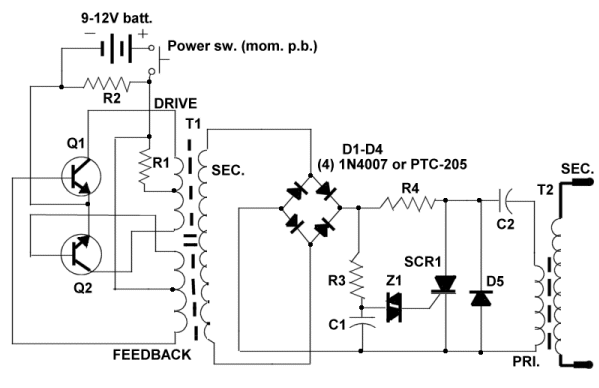
proximity detector schematic

A simple proximity detector electronic project can be designed using this schematic circuit. This project utilizes a tone decoder integrated circuit (NE567), which provides a signal with a frequency of approximately 100 kHz. When an object is placed near the sensor, the capacitance between the sensor increases. The Q1 and Q2 transistors amplify the signal and feed it to the NE567 IC, causing LED1 to glow.
The proximity detector circuit operates by utilizing the NE567 tone decoder, which is sensitive to a specific frequency. The circuit is designed to detect changes in capacitance caused by the presence of an object within its proximity. The NE567 is configured to respond to a frequency of around 100 kHz, which is generated by an oscillator circuit included in the design.
The sensor component typically consists of two conductive plates that form a capacitor. As an object approaches, the capacitance between these plates increases due to the dielectric effect of the object. This change in capacitance alters the frequency of the oscillator, allowing the NE567 to detect the presence of the object.
Transistors Q1 and Q2 serve as amplifiers in the circuit. They are configured to amplify the output signal from the sensor before it reaches the NE567. This amplification is crucial for ensuring that the signal is strong enough for the tone decoder to accurately process it. The output from the NE567 is then used to drive an LED (LED1), which visually indicates the detection of an object. When the circuit is activated, and an object is detected, LED1 will glow, providing a clear indication of proximity.
This circuit is useful for various applications, such as automatic lighting systems, security alarms, or interactive devices, where the detection of nearby objects is necessary. The simplicity of the design makes it accessible for hobbyists and educational purposes, while still demonstrating fundamental principles of electronics and sensor technology.A very simple proximity detector electronic project can be designed using this schematic circuit. This proximity detector electronic project use a tone decoder integrated circuit ( NE567 ) that will provides a signal with a frequency about 100Khz. When an object is placed near the sensor, the capacitance between sensor is increased. The Q1 and Q2 transistors will amplify the signal and fed it to the NE567 IC, that will make the LED1 to glow. 🔗 External reference
The proximity detector circuit operates by utilizing the NE567 tone decoder, which is sensitive to a specific frequency. The circuit is designed to detect changes in capacitance caused by the presence of an object within its proximity. The NE567 is configured to respond to a frequency of around 100 kHz, which is generated by an oscillator circuit included in the design.
The sensor component typically consists of two conductive plates that form a capacitor. As an object approaches, the capacitance between these plates increases due to the dielectric effect of the object. This change in capacitance alters the frequency of the oscillator, allowing the NE567 to detect the presence of the object.
Transistors Q1 and Q2 serve as amplifiers in the circuit. They are configured to amplify the output signal from the sensor before it reaches the NE567. This amplification is crucial for ensuring that the signal is strong enough for the tone decoder to accurately process it. The output from the NE567 is then used to drive an LED (LED1), which visually indicates the detection of an object. When the circuit is activated, and an object is detected, LED1 will glow, providing a clear indication of proximity.
This circuit is useful for various applications, such as automatic lighting systems, security alarms, or interactive devices, where the detection of nearby objects is necessary. The simplicity of the design makes it accessible for hobbyists and educational purposes, while still demonstrating fundamental principles of electronics and sensor technology.A very simple proximity detector electronic project can be designed using this schematic circuit. This proximity detector electronic project use a tone decoder integrated circuit ( NE567 ) that will provides a signal with a frequency about 100Khz. When an object is placed near the sensor, the capacitance between sensor is increased. The Q1 and Q2 transistors will amplify the signal and fed it to the NE567 IC, that will make the LED1 to glow. 🔗 External reference





